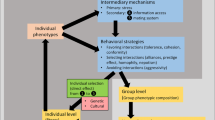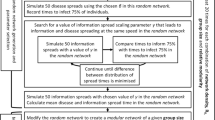Abstract
In myriad biological systems, multiple lines of evidence indicate that modularity, wherein parts of a network are organized into modules such as subgroups in animal networks, may affect social transmission processes. In animal societies, there is increased interest in understanding variation in the effects of modularity on transmission as it may provide important insight into a given network’s performance, in addition to the evolutionary consequences the structure of the network may have for individual fitness. Yet, to our knowledge, the degree to which network efficiency is modularity dependent has not yet been investigated in great detail in behavioral and evolutionary ecology. Here, we investigated to what degree network efficiency, as a proxy for social transmission, is modularity dependent. We created 2798 networks varying in group size and density, and tested whether network structure (density, Newman’s modularity, eigenvector centralization) and group size shape network efficiency. We also used published data from 41 primate social networks to test whether the predictions generated in our simulations were supported by empirical observations. Our results show a non-linear relationship between modularity and global efficiency, with the latter peaking at intermediate values of modularity in both theoretical and empirical networks. This phenomenon may have relevance for observed variation in social structure and its link with network performance. Our results may thus provide a basis from which to discuss the evolution of complex systems such as animal societies.
Significance statement
Networks may maximize performance and minimize transmission costs, as demonstrated in neural networks, but to what degree network efficiency is modularity dependent has not yet been investigated in behavioral ecology. We provide evidence that modularity, such as subgrouping in animal networks, can have non-linear effects on transmission processes, with low values of modularity tending to positively influence social transmission and high values tending to negatively influence transmission. This pattern was consistent across small, medium, and large social groups from theoretical networks, and was corroborated by our empirical networks which were derived from 41 small- to medium-sized groups of 15 primate species. These results have potential implications for the understanding of social flexibility and its link with network performance, in addition informing many interdisciplinary fields, such as communication and computer science.



Similar content being viewed by others
Data availability
The dataset generated during the current study are available in the figshare repository (https://figshare.com/s/bc4b2c78b3614eb51246).
References
Ancel LW, Fontana W (2000) Plasticity, evolvability, and modularity in RNA. J Exp Zool 288:242–283
Barabási AL (2016) Network science. Cambridge University Press, Cambridge
Berlot R, Metzler-Baddeley C, Ikram MA, Jones DK, O’Sullivan MJ (2016) Global efficiency of structural networks mediates cognitive control in mild cognitive impairment. Front Aging Neurosci 8:292
Clune J, Mouret JB, Lipson H (2013) The evolutionary origins of modularity. Proc R Soc B 280:20122863
Coussi-Korbel S, Fragaszy D (1995) On the relation between social dynamics and social learning. Anim Behav 50:1441–1453
Csárdi G, Nepusz T (2006) The igraph software package for complex network research. Int J Complex Syst 1695:1–9
Dall SRX, Giraldeau LA, Olsson O, McNamara JM, Stephens DW (2015) Information and its use by animals in evolutionary ecology. Trends Ecol Evol 20:187–193
Danchin E, Giraldeau LA, Valone TJ, Wagner RH (2004) Public information: from nosy neighbors to cultural evolution. Science 305:487–491
Deem SL, Karesh WB, Weisman W (2001) Putting theory into practice: wildlife health in conservation. Conserv Biol 15:1224–1233
Duboscq J, Romano V, MacIntosh AJJ, Sueur C (2016) Social information transmission in animals: lessons from studies of diffusion. Front Psychol 7:1147
Ellis S, Franks DW, Nattrass S, Cant MA, Weiss MN, Giles D, Balcomb KC, Croft DP (2017) Mortality risk and social network position in resident killer whales: sex differences and the importance of resource abundance. Proc R Soc B 284:20171313
Farine DR, Whitehead H (2015) Constructing, conducting, and interpreting animal social network analysis. J Anim Ecol 84:1144–1163
Field A, Miles J, Field Z (2012) Discovering statistics using R. SAGE Publications Ltd, Thousand Oaks
Flack A, Biro D, Guilford T, Freeman R (2015) Modelling group navigation: transitive social structures improve navigational performance. J R Soc Interface 12:20150213
Formica VA, Wood CW, Larsen WB, Butterfield RE, Augat ME, Hougen HY, Brodie ED (2012) Fitness consequences of social network position in a wild population of forked fungus beetles (Bolitotherus cornutus). J Evol Biol 25:130–137
Fruteau C, Voelkl B, van Damme E, Nöe R (2009) Supply and demand determine the market value of food providers in wild vervet monkeys. Proc Natl Acad Sci USA 106:12007–12012
Girvan M, Newman MEJ (2002) Community structure in social and biological networks. Proc Natl Acad Sci USA 99:7821–7826
Griffin RH, Nunn CL (2012) Community structure and the spread of infectious disease in primate social networks. Evol Ecol 26:779–800
Heide-Jorgensen MP, Harkonen T, Dietz R, Thompson PM (1992) Retrospective of the 1988 European seal epizootic. Dis Aquat Org 13:37–62
Henrich J, Gil-White FJ (2001) The evolution of prestige: freely conferred deference as a mechanism for enhancing the benefits of cultural transmission. Evol Hum Behav 22:165–196
Hinde RA (1976) Interactions, relationships and social structure. Man 11:1–17
Kappeler PM, Cremer S, Nunn CL (2015) Sociality and health: impacts of sociality on disease susceptibility and transmission in animal and human societies. Philos Trans R Soc B 370:20140116
Kappeler PM, van Schaik CP (2002) Evolution of primate social systems. Int J Primatol 23:707–740
Kashima K, Ohtsuki H, Satake A (2013) Fission–fusion bat behavior as a strategy for balancing the conflicting needs of maximizing information accuracy and minimizing infection risk. J Theor Biol 318:101–109
Kendal RL, Coolen I, van Bergen Y, Laland KN (2005) Trade-offs in the adaptive use of social and asocial learning. Adv Study Behav 35:333–379
Klingenberg CP (2008) Morphological integration and developmental modularity. Annu Rev Ecol Evol Syst 39:115–132
Lamberson WR, Firman JD (2002) A comparison of quadratic versus segmented regression procedures for estimating nutrient requirements. Poult Sci 81:481–484
Lehmann J, Bonaventura M, McFarland R (2016) The effects of social network position on the survival of wild barbary macaques, Macaca sylvanus. Behav Ecol 27:20–28
Lentz HHK, Selhorst T, Sokolov IM (2012) Spread of infectious diseases in directed and modular metapopulation networks. Phys Rev E 85:1–9
Lloyd-Smith JO, Schreiber SJ, Kopp PE, Getz WM (2005) Superspreading and the effect of individual variation on disease emergence. Nature 438:355–359
Lopes PC, Block P, König B (2016) Infection-induced behavioural changes reduced connectivity and the potential for disease spread in wild mice contact networks. Sci Rep 6:31790
Lusseau D (2003) The emergent properties of a dolphin social network. Proc R Soc Lond B 7:186–188
MacIntosh AJJ, Jacobs A, Garcia C, Shimizu K, Mouri K, Huffman MA, Hernandez AD (2012) Monkeys in the middle: parasite transmission through the social network of a wild primate. PLoS One 7:e51144
McPherson M, Smith-Lovin L, Cook JM (2001) Birds of a feather: homophily in social networks. Annu Rev Sociol 27:415–444
Muggeo VMR (2008) Segmented: an R package to fit regression models with broken-line relationships. R News 8:20–25
Nematzadeh A, Ferrara E, Flammini A, Ahn YY (2014) Optimal network modularity for information diffusion. Phys Rev Lett 113:088701
Newman MEJ (2006) Modularity and community structure in networks. Proc Natl Acad Sci USA 103:8577–8582
Nuñez CMV, Adelman JS, Rubenstein DI (2015) Sociality increases juvenile survival after a catastrophic event in the feral horse (Equus caballus). Behav Ecol 26:138–147
Nunn CL, Jordán F, McCabe CM, Verdolin JL, Fewell JH (2015) Infectious disease and group size: more than just a numbers game. Philos Trans R Soc B 370:2014011
Pasquaretta C, Levé M, Claidière N et al (2014) Social networks in primates: smart and tolerant species have more efficient networks. Sci Rep 4:7600
Plowright W (1982) The effects of rinderpest and rinderpest control on wildlife in Africa. Symp Zool Soc 50:1–28
Poirotte C, Massol F, Herbert A, Willaume E, Bomo PM, Kapeller PM, Charpentier MJE (2017) Mandrills use olfaction to socially avoid parasitized conspecifics. Sci Adv 3:e1601721
Puga-Gonzalez I, Sueur C (2017) Friendships and social networks in an individual-based model of primate social behaviour. JASSS 20:10
R Core Team (2016) R: A language and environment for statistical computing. R Foundation for Statistical Computing, Vienna http://www.R-project.org/
Romano V (2017) Social networks as a trade-off between optimal information transmission and reduced disease transmission. Dissertation, Université de Strasbourg
Romano V, Duboscq J, Sarabian C, Thomas E, Sueur C, MacIntosh AJJ (2016) Modeling infection transmission in primate networks to predict centrality-based risk. Am J Primatol 28:767–779
Rushmore J, Caillaud D, Matamba L, Stumpf RM, Borgatti SP, Altizer S (2013) Social network analysis of wild chimpanzees provides insights for predicting infectious disease risk. J Anim Ecol 82:976–986
Ryder TB, Parker PG, Blake JG, Loiselle BA (2009) It takes two to tango: reproductive skew and social correlates of male mating success in a lek-breeding bird. Proc R Soc Lond B 276:2377–2384
Sah P, Leu ST, Cross PC, Hudson PJ, Bansal S (2017) Unraveling the disease consequences and mechanisms of modular structure in animal social networks. Proc Natl Acad Sci USA 114:4165–4170
Schoepf I, Schradin C (2012) Better off alone! Reproductive competition and ecological constraints determine sociality in the African striped mouse (Rhabdomys pumilio). J Anim Ecol 81:649–656
Scott J (2017) Social network analysis. Sage Publications Ltd, Thousand Oaks
Strandburg-Peshkin A, Twomey CR, Bode NWF et al (2013) Visual sensory networks and effective information transfer in animal groups. Curr Biol 23:709–711
Sueur C (2011) Social network, information flow and decision-making efficiency: a comparison of humans and animals. In: Safar M, Mahdi K (eds) Social networking and community behavior modeling: qualitative and quantitative measures, 1st edn. IGI Global, Hershey, pp 164–177
Sueur C, Deneubourg JL, Petit O (2012) From social network (centralized to decentralized) to collective decision making (unshared vs. shared consensus). PLoS One 7:e32566
Sueur C, Petit O, de Marco A, Jacobs AT, Watanabe K, Thierry B (2011) A comparative network analysis of social style in macaques. Anim Behav 82:845–852
Tokuyama N, Furuichi T (2016) Do friends help each other? Patterns of female coalition formation in wild bonobos at Wamba. Anim Behav 119:27–35
VanderWaal KL, Atwill ER, Isbell LA, McCowan B (2014) Quantifying microbe transmission networks for wild and domestic ungulates in Kenya. Biol Conserv 169:136–146
Wagner GP, Pavlicev M, Cheverud JM (2007) The road to modularity. Nat Rev Genet 8:921–931
Walsh PD, Bermejo M, Rodríguez-Teijeiro JD (2009) Disease avoidance and the evolution of primate social connectivity: ebola, bats, gorillas, and chimpanzees. In: Huffman M, Chapman CA (eds) Primate parasite ecology: the dynamics and study of host–parasite relationships, 1st edn. Cambridge University Press, Cambridge, pp 183–198
Weng L, Menczer F, Ahn YY (2013) Virality prediction and community structure in social networks. Sci Rep 3:2522
Wey T, Blumstein DT, Shen W, Jordán F (2008) Social network analysis of animal behavior: a promising tool for the study of sociality. Anim Behav 75:333–344
Wey TW, Blumstein DT (2012) Social attributes and associated performance measures in marmots: bigger male bullies and weakly affiliating females have higher annual reproductive success. Behav Ecol Sociobiol 66:1075–1085
Whitehead H (2008) Analyzing animal societies: quantitative methods for vertebrate social analysis. The University of Chicago Press, Chicago
Wickham H (2009) ggplot2: elegant graphics for data analysis. Springer-Verlag, New York
Acknowledgments
Funding
V.R. was supported by the Brazilian Ministry of Education (CAPES), A.J.J.M. was supported by Grants-in-Aid from the Japan Society for the Promotion of Science (JSPS), and C.S. was funded by the University of Strasbourg Institute for Advanced Studies (USIAS), by an ANR program Blanc grant (HANC, ANR-15-CE36-0005-01) and a CNRS PICS program (exchange with Japan, no. 7455). V.R. also received support from the JSPS.
Author information
Authors and Affiliations
Contributions
V.R., C.S., and A.J.J.M. conceptualized the study. M.S. created the theoretical networks and conducted exploratory analyses; V.R. performed statistical analyses and wrote the manuscript; A.J.J.M. and C.S. significantly contributed to the manuscript development; M.S. and J.P. provided additional comments.
Corresponding author
Additional information
Communicated by D. P. Croft
Electronic supplementary material
ESM 1
(DOC 2051 kb)
Rights and permissions
About this article
Cite this article
Romano, V., Shen, M., Pansanel, J. et al. Social transmission in networks: global efficiency peaks with intermediate levels of modularity. Behav Ecol Sociobiol 72, 154 (2018). https://doi.org/10.1007/s00265-018-2564-9
Received:
Revised:
Accepted:
Published:
DOI: https://doi.org/10.1007/s00265-018-2564-9




